Orchids are an extraordinarily large group of plants encompassing around 28,000 identified species, across 800 genera. The best method of orchid propagation varies by species – each type has a couple of different ways of reproducing. In home cultivation, orchids are most often propagated vegetatively, through cuttings or division. They may also be grown from seed in specific conditions – but this can be a slow process. Proper orchid care is essential in nurturing both the seedlings and the parent plants, which must be in good health to produce new plants.
Which Type Of Orchid?
Despite the many different types of orchids, they only have two main growth patterns: monopodial or sympodial. Before you begin propagation you need to know which type it is.
Monopodial plants have a single root system that cannot be divided. They are commonly propagated through keikis, which are plantlets that grow from the flowering stem. However, some growers are successful at taking stem cuttings.Sympodial plants produce pseudobulbs, which are similar to rhizomes and can be broken apart and repotted separately in a new container.
In this article we reveal the main orchid propagation methods suitable for different species.
1. Divide Pseudobulbs
Sympodial orchids develop pseudobulbs – green, bulbous growths at the base of the plant that form on lateral or terminal rhizomes. The bulbs hold water and nutrients, acting as a storage unit during periods of dry weather. Each pseudobulb has the potential to become a new plant, and dividing them is a fairly easy way to grow your orchid collection. It is also the quickest solution because the little plant already has roots and can begin to grow into its container. Examples of commonly grown orchids with pseudobulbs are Cattleya, Oncidium, Dendrobium, Epidendrum, and Laela. Unfortunately, this is not a suitable method for propagating orchids without pseudobulb organs, such as the ever-popular Phaeleonopsis. Don’t harvest pseudobulbs from an orchid unless your plant is mature and healthy.
2. Encourage Keikis
Certain types of orchids produce keikis – which is Hawaiin for “children”. They are baby plants, or offshoots, of the mother plant. Cultivating keikis is one of the easiest methods of propagating orchids. Dendrobium, Phalaenopsis, Oncidium, and Epidendrum orchids may all produce keikis. These baby orchids can be encouraged to form by cutting a spent stem back. This encourages a second stem to grow. Keikis look like a flower spike initially, but they will soon form leaves and aerial roots. If they are left on the plant, the parent is stressed from diverting energy to this emerging new plant, so if you spot a keiki, it is best to remove and repot it. Like pseudobulbs, keikis are instant plants and simply need time to adjust to their new container and settle in.
3. Grow Orchids From Cuttings
There is some controversy over this method, as many gardeners have tried and failed to grow orchids from cuttings. Still, others swear by it, and you have nothing to lose by trying. Vanda and Phalaenopsis orchids may be grown from cuttings.
4. Propagate Orchids From Seed
This is where things get tricky. Growing orchids from seed requires specialized conditions and a sterile environment. It is a lot of effort for home growers to achieve, but possible if you have the patience. You can try the method with any orchid seed pod, but growing rare varieties holds particular appeal. Bear in mind it may take several years before orchids grown from seeds produce flowers. The method to obtain germination at home is called Asymbiotic germination, or flasking. The seeds will be placed in a clear flask in a jelly-like agar substance. You can purchase prepared agar or make your own using agar powder and hot water. To mix it, boil 3.4oz (100ml) of water and add to 0.8oz (25g) of agar powder. Stir the powder in thoroughly.
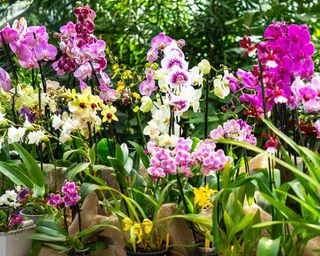
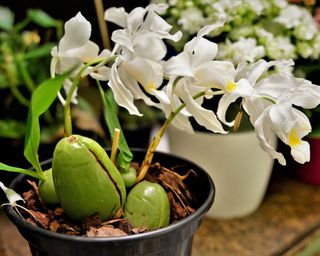
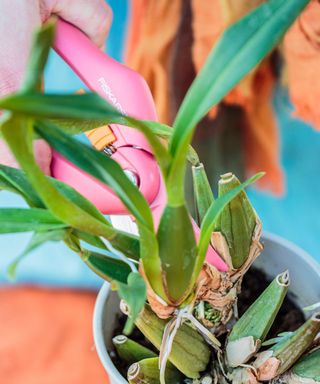
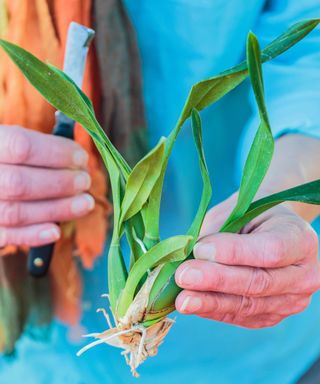
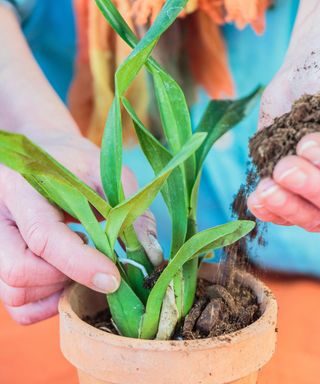
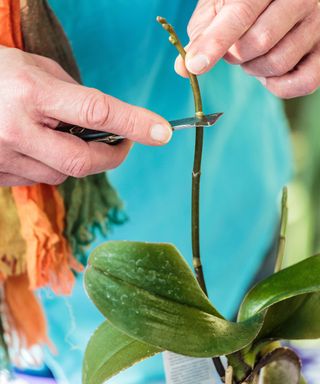
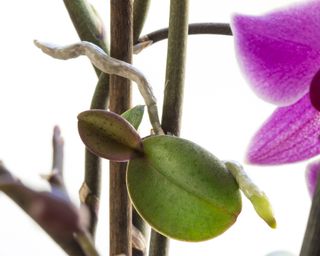
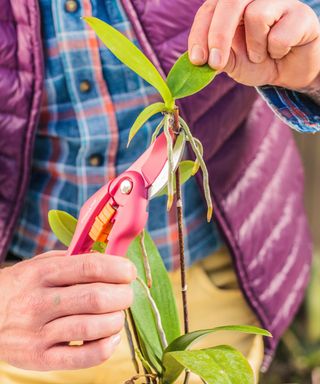

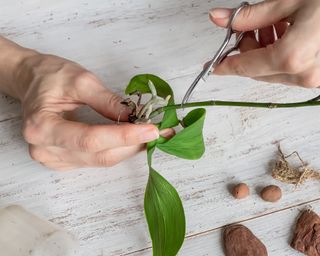
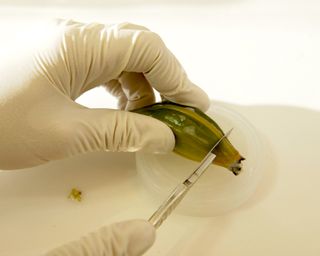
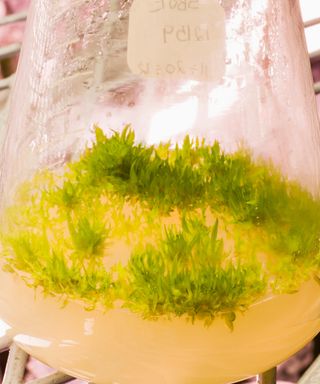
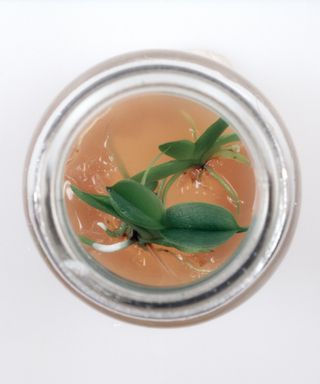
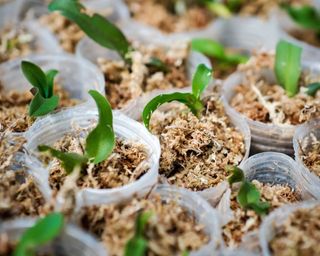
title: “How To Propagate Orchids 4 Methods To Grow Your Collection” ShowToc: true date: “2024-09-11” author: “Wendy Jett”
Orchids are an extraordinarily large group of plants encompassing around 28,000 identified species, across 800 genera. The best method of orchid propagation varies by species – each type has a couple of different ways of reproducing. In home cultivation, orchids are most often propagated vegetatively, through cuttings or division. They may also be grown from seed in specific conditions – but this can be a slow process. Proper orchid care is essential in nurturing both the seedlings and the parent plants, which must be in good health to produce new plants.
Which Type Of Orchid?
Despite the many different types of orchids, they only have two main growth patterns: monopodial or sympodial. Before you begin propagation you need to know which type it is.
Monopodial plants have a single root system that cannot be divided. They are commonly propagated through keikis, which are plantlets that grow from the flowering stem. However, some growers are successful at taking stem cuttings.Sympodial plants produce pseudobulbs, which are similar to rhizomes and can be broken apart and repotted separately in a new container.
In this article we reveal the main orchid propagation methods suitable for different species.
1. Divide Pseudobulbs
Sympodial orchids develop pseudobulbs – green, bulbous growths at the base of the plant that form on lateral or terminal rhizomes. The bulbs hold water and nutrients, acting as a storage unit during periods of dry weather. Each pseudobulb has the potential to become a new plant, and dividing them is a fairly easy way to grow your orchid collection. It is also the quickest solution because the little plant already has roots and can begin to grow into its container. Examples of commonly grown orchids with pseudobulbs are Cattleya, Oncidium, Dendrobium, Epidendrum, and Laela. Unfortunately, this is not a suitable method for propagating orchids without pseudobulb organs, such as the ever-popular Phaeleonopsis. Don’t harvest pseudobulbs from an orchid unless your plant is mature and healthy.
2. Encourage Keikis
Certain types of orchids produce keikis – which is Hawaiin for “children”. They are baby plants, or offshoots, of the mother plant. Cultivating keikis is one of the easiest methods of propagating orchids. Dendrobium, Phalaenopsis, Oncidium, and Epidendrum orchids may all produce keikis. These baby orchids can be encouraged to form by cutting a spent stem back. This encourages a second stem to grow. Keikis look like a flower spike initially, but they will soon form leaves and aerial roots. If they are left on the plant, the parent is stressed from diverting energy to this emerging new plant, so if you spot a keiki, it is best to remove and repot it. Like pseudobulbs, keikis are instant plants and simply need time to adjust to their new container and settle in.
3. Grow Orchids From Cuttings
There is some controversy over this method, as many gardeners have tried and failed to grow orchids from cuttings. Still, others swear by it, and you have nothing to lose by trying. Vanda and Phalaenopsis orchids may be grown from cuttings.
4. Propagate Orchids From Seed
This is where things get tricky. Growing orchids from seed requires specialized conditions and a sterile environment. It is a lot of effort for home growers to achieve, but possible if you have the patience. You can try the method with any orchid seed pod, but growing rare varieties holds particular appeal. Bear in mind it may take several years before orchids grown from seeds produce flowers. The method to obtain germination at home is called Asymbiotic germination, or flasking. The seeds will be placed in a clear flask in a jelly-like agar substance. You can purchase prepared agar or make your own using agar powder and hot water. To mix it, boil 3.4oz (100ml) of water and add to 0.8oz (25g) of agar powder. Stir the powder in thoroughly.














title: “How To Propagate Orchids 4 Methods To Grow Your Collection” ShowToc: true date: “2024-09-02” author: “Mary Lovelace”
Orchids are an extraordinarily large group of plants encompassing around 28,000 identified species, across 800 genera. The best method of orchid propagation varies by species – each type has a couple of different ways of reproducing. In home cultivation, orchids are most often propagated vegetatively, through cuttings or division. They may also be grown from seed in specific conditions – but this can be a slow process. Proper orchid care is essential in nurturing both the seedlings and the parent plants, which must be in good health to produce new plants.
Which Type Of Orchid?
Despite the many different types of orchids, they only have two main growth patterns: monopodial or sympodial. Before you begin propagation you need to know which type it is.
Monopodial plants have a single root system that cannot be divided. They are commonly propagated through keikis, which are plantlets that grow from the flowering stem. However, some growers are successful at taking stem cuttings.Sympodial plants produce pseudobulbs, which are similar to rhizomes and can be broken apart and repotted separately in a new container.
In this article we reveal the main orchid propagation methods suitable for different species.
1. Divide Pseudobulbs
Sympodial orchids develop pseudobulbs – green, bulbous growths at the base of the plant that form on lateral or terminal rhizomes. The bulbs hold water and nutrients, acting as a storage unit during periods of dry weather. Each pseudobulb has the potential to become a new plant, and dividing them is a fairly easy way to grow your orchid collection. It is also the quickest solution because the little plant already has roots and can begin to grow into its container. Examples of commonly grown orchids with pseudobulbs are Cattleya, Oncidium, Dendrobium, Epidendrum, and Laela. Unfortunately, this is not a suitable method for propagating orchids without pseudobulb organs, such as the ever-popular Phaeleonopsis. Don’t harvest pseudobulbs from an orchid unless your plant is mature and healthy.
2. Encourage Keikis
Certain types of orchids produce keikis – which is Hawaiin for “children”. They are baby plants, or offshoots, of the mother plant. Cultivating keikis is one of the easiest methods of propagating orchids. Dendrobium, Phalaenopsis, Oncidium, and Epidendrum orchids may all produce keikis. These baby orchids can be encouraged to form by cutting a spent stem back. This encourages a second stem to grow. Keikis look like a flower spike initially, but they will soon form leaves and aerial roots. If they are left on the plant, the parent is stressed from diverting energy to this emerging new plant, so if you spot a keiki, it is best to remove and repot it. Like pseudobulbs, keikis are instant plants and simply need time to adjust to their new container and settle in.
3. Grow Orchids From Cuttings
There is some controversy over this method, as many gardeners have tried and failed to grow orchids from cuttings. Still, others swear by it, and you have nothing to lose by trying. Vanda and Phalaenopsis orchids may be grown from cuttings.
4. Propagate Orchids From Seed
This is where things get tricky. Growing orchids from seed requires specialized conditions and a sterile environment. It is a lot of effort for home growers to achieve, but possible if you have the patience. You can try the method with any orchid seed pod, but growing rare varieties holds particular appeal. Bear in mind it may take several years before orchids grown from seeds produce flowers. The method to obtain germination at home is called Asymbiotic germination, or flasking. The seeds will be placed in a clear flask in a jelly-like agar substance. You can purchase prepared agar or make your own using agar powder and hot water. To mix it, boil 3.4oz (100ml) of water and add to 0.8oz (25g) of agar powder. Stir the powder in thoroughly.














title: “How To Propagate Orchids 4 Methods To Grow Your Collection” ShowToc: true date: “2024-09-28” author: “Ruth Waterman”
Orchids are an extraordinarily large group of plants encompassing around 28,000 identified species, across 800 genera. The best method of orchid propagation varies by species – each type has a couple of different ways of reproducing. In home cultivation, orchids are most often propagated vegetatively, through cuttings or division. They may also be grown from seed in specific conditions – but this can be a slow process. Proper orchid care is essential in nurturing both the seedlings and the parent plants, which must be in good health to produce new plants.
Which Type Of Orchid?
Despite the many different types of orchids, they only have two main growth patterns: monopodial or sympodial. Before you begin propagation you need to know which type it is.
Monopodial plants have a single root system that cannot be divided. They are commonly propagated through keikis, which are plantlets that grow from the flowering stem. However, some growers are successful at taking stem cuttings.Sympodial plants produce pseudobulbs, which are similar to rhizomes and can be broken apart and repotted separately in a new container.
In this article we reveal the main orchid propagation methods suitable for different species.
1. Divide Pseudobulbs
Sympodial orchids develop pseudobulbs – green, bulbous growths at the base of the plant that form on lateral or terminal rhizomes. The bulbs hold water and nutrients, acting as a storage unit during periods of dry weather. Each pseudobulb has the potential to become a new plant, and dividing them is a fairly easy way to grow your orchid collection. It is also the quickest solution because the little plant already has roots and can begin to grow into its container. Examples of commonly grown orchids with pseudobulbs are Cattleya, Oncidium, Dendrobium, Epidendrum, and Laela. Unfortunately, this is not a suitable method for propagating orchids without pseudobulb organs, such as the ever-popular Phaeleonopsis. Don’t harvest pseudobulbs from an orchid unless your plant is mature and healthy.
2. Encourage Keikis
Certain types of orchids produce keikis – which is Hawaiin for “children”. They are baby plants, or offshoots, of the mother plant. Cultivating keikis is one of the easiest methods of propagating orchids. Dendrobium, Phalaenopsis, Oncidium, and Epidendrum orchids may all produce keikis. These baby orchids can be encouraged to form by cutting a spent stem back. This encourages a second stem to grow. Keikis look like a flower spike initially, but they will soon form leaves and aerial roots. If they are left on the plant, the parent is stressed from diverting energy to this emerging new plant, so if you spot a keiki, it is best to remove and repot it. Like pseudobulbs, keikis are instant plants and simply need time to adjust to their new container and settle in.
3. Grow Orchids From Cuttings
There is some controversy over this method, as many gardeners have tried and failed to grow orchids from cuttings. Still, others swear by it, and you have nothing to lose by trying. Vanda and Phalaenopsis orchids may be grown from cuttings.
4. Propagate Orchids From Seed
This is where things get tricky. Growing orchids from seed requires specialized conditions and a sterile environment. It is a lot of effort for home growers to achieve, but possible if you have the patience. You can try the method with any orchid seed pod, but growing rare varieties holds particular appeal. Bear in mind it may take several years before orchids grown from seeds produce flowers. The method to obtain germination at home is called Asymbiotic germination, or flasking. The seeds will be placed in a clear flask in a jelly-like agar substance. You can purchase prepared agar or make your own using agar powder and hot water. To mix it, boil 3.4oz (100ml) of water and add to 0.8oz (25g) of agar powder. Stir the powder in thoroughly.














title: “How To Propagate Orchids 4 Methods To Grow Your Collection” ShowToc: true date: “2024-09-15” author: “Philip Mackey”
Orchids are an extraordinarily large group of plants encompassing around 28,000 identified species, across 800 genera. The best method of orchid propagation varies by species – each type has a couple of different ways of reproducing. In home cultivation, orchids are most often propagated vegetatively, through cuttings or division. They may also be grown from seed in specific conditions – but this can be a slow process. Proper orchid care is essential in nurturing both the seedlings and the parent plants, which must be in good health to produce new plants.
Which Type Of Orchid?
Despite the many different types of orchids, they only have two main growth patterns: monopodial or sympodial. Before you begin propagation you need to know which type it is.
Monopodial plants have a single root system that cannot be divided. They are commonly propagated through keikis, which are plantlets that grow from the flowering stem. However, some growers are successful at taking stem cuttings.Sympodial plants produce pseudobulbs, which are similar to rhizomes and can be broken apart and repotted separately in a new container.
In this article we reveal the main orchid propagation methods suitable for different species.
1. Divide Pseudobulbs
Sympodial orchids develop pseudobulbs – green, bulbous growths at the base of the plant that form on lateral or terminal rhizomes. The bulbs hold water and nutrients, acting as a storage unit during periods of dry weather. Each pseudobulb has the potential to become a new plant, and dividing them is a fairly easy way to grow your orchid collection. It is also the quickest solution because the little plant already has roots and can begin to grow into its container. Examples of commonly grown orchids with pseudobulbs are Cattleya, Oncidium, Dendrobium, Epidendrum, and Laela. Unfortunately, this is not a suitable method for propagating orchids without pseudobulb organs, such as the ever-popular Phaeleonopsis. Don’t harvest pseudobulbs from an orchid unless your plant is mature and healthy.
2. Encourage Keikis
Certain types of orchids produce keikis – which is Hawaiin for “children”. They are baby plants, or offshoots, of the mother plant. Cultivating keikis is one of the easiest methods of propagating orchids. Dendrobium, Phalaenopsis, Oncidium, and Epidendrum orchids may all produce keikis. These baby orchids can be encouraged to form by cutting a spent stem back. This encourages a second stem to grow. Keikis look like a flower spike initially, but they will soon form leaves and aerial roots. If they are left on the plant, the parent is stressed from diverting energy to this emerging new plant, so if you spot a keiki, it is best to remove and repot it. Like pseudobulbs, keikis are instant plants and simply need time to adjust to their new container and settle in.
3. Grow Orchids From Cuttings
There is some controversy over this method, as many gardeners have tried and failed to grow orchids from cuttings. Still, others swear by it, and you have nothing to lose by trying. Vanda and Phalaenopsis orchids may be grown from cuttings.
4. Propagate Orchids From Seed
This is where things get tricky. Growing orchids from seed requires specialized conditions and a sterile environment. It is a lot of effort for home growers to achieve, but possible if you have the patience. You can try the method with any orchid seed pod, but growing rare varieties holds particular appeal. Bear in mind it may take several years before orchids grown from seeds produce flowers. The method to obtain germination at home is called Asymbiotic germination, or flasking. The seeds will be placed in a clear flask in a jelly-like agar substance. You can purchase prepared agar or make your own using agar powder and hot water. To mix it, boil 3.4oz (100ml) of water and add to 0.8oz (25g) of agar powder. Stir the powder in thoroughly.














title: “How To Propagate Orchids 4 Methods To Grow Your Collection” ShowToc: true date: “2024-10-02” author: “Virginia Hunt”
Orchids are an extraordinarily large group of plants encompassing around 28,000 identified species, across 800 genera. The best method of orchid propagation varies by species – each type has a couple of different ways of reproducing. In home cultivation, orchids are most often propagated vegetatively, through cuttings or division. They may also be grown from seed in specific conditions – but this can be a slow process. Proper orchid care is essential in nurturing both the seedlings and the parent plants, which must be in good health to produce new plants.
Which Type Of Orchid?
Despite the many different types of orchids, they only have two main growth patterns: monopodial or sympodial. Before you begin propagation you need to know which type it is.
Monopodial plants have a single root system that cannot be divided. They are commonly propagated through keikis, which are plantlets that grow from the flowering stem. However, some growers are successful at taking stem cuttings.Sympodial plants produce pseudobulbs, which are similar to rhizomes and can be broken apart and repotted separately in a new container.
In this article we reveal the main orchid propagation methods suitable for different species.
1. Divide Pseudobulbs
Sympodial orchids develop pseudobulbs – green, bulbous growths at the base of the plant that form on lateral or terminal rhizomes. The bulbs hold water and nutrients, acting as a storage unit during periods of dry weather. Each pseudobulb has the potential to become a new plant, and dividing them is a fairly easy way to grow your orchid collection. It is also the quickest solution because the little plant already has roots and can begin to grow into its container. Examples of commonly grown orchids with pseudobulbs are Cattleya, Oncidium, Dendrobium, Epidendrum, and Laela. Unfortunately, this is not a suitable method for propagating orchids without pseudobulb organs, such as the ever-popular Phaeleonopsis. Don’t harvest pseudobulbs from an orchid unless your plant is mature and healthy.
2. Encourage Keikis
Certain types of orchids produce keikis – which is Hawaiin for “children”. They are baby plants, or offshoots, of the mother plant. Cultivating keikis is one of the easiest methods of propagating orchids. Dendrobium, Phalaenopsis, Oncidium, and Epidendrum orchids may all produce keikis. These baby orchids can be encouraged to form by cutting a spent stem back. This encourages a second stem to grow. Keikis look like a flower spike initially, but they will soon form leaves and aerial roots. If they are left on the plant, the parent is stressed from diverting energy to this emerging new plant, so if you spot a keiki, it is best to remove and repot it. Like pseudobulbs, keikis are instant plants and simply need time to adjust to their new container and settle in.
3. Grow Orchids From Cuttings
There is some controversy over this method, as many gardeners have tried and failed to grow orchids from cuttings. Still, others swear by it, and you have nothing to lose by trying. Vanda and Phalaenopsis orchids may be grown from cuttings.
4. Propagate Orchids From Seed
This is where things get tricky. Growing orchids from seed requires specialized conditions and a sterile environment. It is a lot of effort for home growers to achieve, but possible if you have the patience. You can try the method with any orchid seed pod, but growing rare varieties holds particular appeal. Bear in mind it may take several years before orchids grown from seeds produce flowers. The method to obtain germination at home is called Asymbiotic germination, or flasking. The seeds will be placed in a clear flask in a jelly-like agar substance. You can purchase prepared agar or make your own using agar powder and hot water. To mix it, boil 3.4oz (100ml) of water and add to 0.8oz (25g) of agar powder. Stir the powder in thoroughly.














title: “How To Propagate Orchids 4 Methods To Grow Your Collection” ShowToc: true date: “2024-08-27” author: “Edgar Cohen”
Orchids are an extraordinarily large group of plants encompassing around 28,000 identified species, across 800 genera. The best method of orchid propagation varies by species – each type has a couple of different ways of reproducing. In home cultivation, orchids are most often propagated vegetatively, through cuttings or division. They may also be grown from seed in specific conditions – but this can be a slow process. Proper orchid care is essential in nurturing both the seedlings and the parent plants, which must be in good health to produce new plants.
Which Type Of Orchid?
Despite the many different types of orchids, they only have two main growth patterns: monopodial or sympodial. Before you begin propagation you need to know which type it is.
Monopodial plants have a single root system that cannot be divided. They are commonly propagated through keikis, which are plantlets that grow from the flowering stem. However, some growers are successful at taking stem cuttings.Sympodial plants produce pseudobulbs, which are similar to rhizomes and can be broken apart and repotted separately in a new container.
In this article we reveal the main orchid propagation methods suitable for different species.
1. Divide Pseudobulbs
Sympodial orchids develop pseudobulbs – green, bulbous growths at the base of the plant that form on lateral or terminal rhizomes. The bulbs hold water and nutrients, acting as a storage unit during periods of dry weather. Each pseudobulb has the potential to become a new plant, and dividing them is a fairly easy way to grow your orchid collection. It is also the quickest solution because the little plant already has roots and can begin to grow into its container. Examples of commonly grown orchids with pseudobulbs are Cattleya, Oncidium, Dendrobium, Epidendrum, and Laela. Unfortunately, this is not a suitable method for propagating orchids without pseudobulb organs, such as the ever-popular Phaeleonopsis. Don’t harvest pseudobulbs from an orchid unless your plant is mature and healthy.
2. Encourage Keikis
Certain types of orchids produce keikis – which is Hawaiin for “children”. They are baby plants, or offshoots, of the mother plant. Cultivating keikis is one of the easiest methods of propagating orchids. Dendrobium, Phalaenopsis, Oncidium, and Epidendrum orchids may all produce keikis. These baby orchids can be encouraged to form by cutting a spent stem back. This encourages a second stem to grow. Keikis look like a flower spike initially, but they will soon form leaves and aerial roots. If they are left on the plant, the parent is stressed from diverting energy to this emerging new plant, so if you spot a keiki, it is best to remove and repot it. Like pseudobulbs, keikis are instant plants and simply need time to adjust to their new container and settle in.
3. Grow Orchids From Cuttings
There is some controversy over this method, as many gardeners have tried and failed to grow orchids from cuttings. Still, others swear by it, and you have nothing to lose by trying. Vanda and Phalaenopsis orchids may be grown from cuttings.
4. Propagate Orchids From Seed
This is where things get tricky. Growing orchids from seed requires specialized conditions and a sterile environment. It is a lot of effort for home growers to achieve, but possible if you have the patience. You can try the method with any orchid seed pod, but growing rare varieties holds particular appeal. Bear in mind it may take several years before orchids grown from seeds produce flowers. The method to obtain germination at home is called Asymbiotic germination, or flasking. The seeds will be placed in a clear flask in a jelly-like agar substance. You can purchase prepared agar or make your own using agar powder and hot water. To mix it, boil 3.4oz (100ml) of water and add to 0.8oz (25g) of agar powder. Stir the powder in thoroughly.














title: “How To Propagate Orchids 4 Methods To Grow Your Collection” ShowToc: true date: “2024-08-27” author: “Heather Wade”
Orchids are an extraordinarily large group of plants encompassing around 28,000 identified species, across 800 genera. The best method of orchid propagation varies by species – each type has a couple of different ways of reproducing. In home cultivation, orchids are most often propagated vegetatively, through cuttings or division. They may also be grown from seed in specific conditions – but this can be a slow process. Proper orchid care is essential in nurturing both the seedlings and the parent plants, which must be in good health to produce new plants.
Which Type Of Orchid?
Despite the many different types of orchids, they only have two main growth patterns: monopodial or sympodial. Before you begin propagation you need to know which type it is.
Monopodial plants have a single root system that cannot be divided. They are commonly propagated through keikis, which are plantlets that grow from the flowering stem. However, some growers are successful at taking stem cuttings.Sympodial plants produce pseudobulbs, which are similar to rhizomes and can be broken apart and repotted separately in a new container.
In this article we reveal the main orchid propagation methods suitable for different species.
1. Divide Pseudobulbs
Sympodial orchids develop pseudobulbs – green, bulbous growths at the base of the plant that form on lateral or terminal rhizomes. The bulbs hold water and nutrients, acting as a storage unit during periods of dry weather. Each pseudobulb has the potential to become a new plant, and dividing them is a fairly easy way to grow your orchid collection. It is also the quickest solution because the little plant already has roots and can begin to grow into its container. Examples of commonly grown orchids with pseudobulbs are Cattleya, Oncidium, Dendrobium, Epidendrum, and Laela. Unfortunately, this is not a suitable method for propagating orchids without pseudobulb organs, such as the ever-popular Phaeleonopsis. Don’t harvest pseudobulbs from an orchid unless your plant is mature and healthy.
2. Encourage Keikis
Certain types of orchids produce keikis – which is Hawaiin for “children”. They are baby plants, or offshoots, of the mother plant. Cultivating keikis is one of the easiest methods of propagating orchids. Dendrobium, Phalaenopsis, Oncidium, and Epidendrum orchids may all produce keikis. These baby orchids can be encouraged to form by cutting a spent stem back. This encourages a second stem to grow. Keikis look like a flower spike initially, but they will soon form leaves and aerial roots. If they are left on the plant, the parent is stressed from diverting energy to this emerging new plant, so if you spot a keiki, it is best to remove and repot it. Like pseudobulbs, keikis are instant plants and simply need time to adjust to their new container and settle in.
3. Grow Orchids From Cuttings
There is some controversy over this method, as many gardeners have tried and failed to grow orchids from cuttings. Still, others swear by it, and you have nothing to lose by trying. Vanda and Phalaenopsis orchids may be grown from cuttings.
4. Propagate Orchids From Seed
This is where things get tricky. Growing orchids from seed requires specialized conditions and a sterile environment. It is a lot of effort for home growers to achieve, but possible if you have the patience. You can try the method with any orchid seed pod, but growing rare varieties holds particular appeal. Bear in mind it may take several years before orchids grown from seeds produce flowers. The method to obtain germination at home is called Asymbiotic germination, or flasking. The seeds will be placed in a clear flask in a jelly-like agar substance. You can purchase prepared agar or make your own using agar powder and hot water. To mix it, boil 3.4oz (100ml) of water and add to 0.8oz (25g) of agar powder. Stir the powder in thoroughly.














title: “How To Propagate Orchids 4 Methods To Grow Your Collection” ShowToc: true date: “2024-09-29” author: “Harry Garcia”
Orchids are an extraordinarily large group of plants encompassing around 28,000 identified species, across 800 genera. The best method of orchid propagation varies by species – each type has a couple of different ways of reproducing. In home cultivation, orchids are most often propagated vegetatively, through cuttings or division. They may also be grown from seed in specific conditions – but this can be a slow process. Proper orchid care is essential in nurturing both the seedlings and the parent plants, which must be in good health to produce new plants.
Which Type Of Orchid?
Despite the many different types of orchids, they only have two main growth patterns: monopodial or sympodial. Before you begin propagation you need to know which type it is.
Monopodial plants have a single root system that cannot be divided. They are commonly propagated through keikis, which are plantlets that grow from the flowering stem. However, some growers are successful at taking stem cuttings.Sympodial plants produce pseudobulbs, which are similar to rhizomes and can be broken apart and repotted separately in a new container.
In this article we reveal the main orchid propagation methods suitable for different species.
1. Divide Pseudobulbs
Sympodial orchids develop pseudobulbs – green, bulbous growths at the base of the plant that form on lateral or terminal rhizomes. The bulbs hold water and nutrients, acting as a storage unit during periods of dry weather. Each pseudobulb has the potential to become a new plant, and dividing them is a fairly easy way to grow your orchid collection. It is also the quickest solution because the little plant already has roots and can begin to grow into its container. Examples of commonly grown orchids with pseudobulbs are Cattleya, Oncidium, Dendrobium, Epidendrum, and Laela. Unfortunately, this is not a suitable method for propagating orchids without pseudobulb organs, such as the ever-popular Phaeleonopsis. Don’t harvest pseudobulbs from an orchid unless your plant is mature and healthy.
2. Encourage Keikis
Certain types of orchids produce keikis – which is Hawaiin for “children”. They are baby plants, or offshoots, of the mother plant. Cultivating keikis is one of the easiest methods of propagating orchids. Dendrobium, Phalaenopsis, Oncidium, and Epidendrum orchids may all produce keikis. These baby orchids can be encouraged to form by cutting a spent stem back. This encourages a second stem to grow. Keikis look like a flower spike initially, but they will soon form leaves and aerial roots. If they are left on the plant, the parent is stressed from diverting energy to this emerging new plant, so if you spot a keiki, it is best to remove and repot it. Like pseudobulbs, keikis are instant plants and simply need time to adjust to their new container and settle in.
3. Grow Orchids From Cuttings
There is some controversy over this method, as many gardeners have tried and failed to grow orchids from cuttings. Still, others swear by it, and you have nothing to lose by trying. Vanda and Phalaenopsis orchids may be grown from cuttings.
4. Propagate Orchids From Seed
This is where things get tricky. Growing orchids from seed requires specialized conditions and a sterile environment. It is a lot of effort for home growers to achieve, but possible if you have the patience. You can try the method with any orchid seed pod, but growing rare varieties holds particular appeal. Bear in mind it may take several years before orchids grown from seeds produce flowers. The method to obtain germination at home is called Asymbiotic germination, or flasking. The seeds will be placed in a clear flask in a jelly-like agar substance. You can purchase prepared agar or make your own using agar powder and hot water. To mix it, boil 3.4oz (100ml) of water and add to 0.8oz (25g) of agar powder. Stir the powder in thoroughly.













